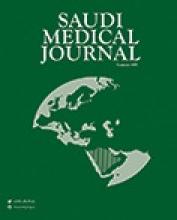Abstract
OBJECTIVE: To compare the epidemiologic, clinical, and pathologic characteristics of symptomatic and incidental renal cell carcinoma (RCC) in Jordan, with some emphasis on age distribution and its potential effect in defining groups of patients that may benefit from early detection programs. We compared our results with the published western figures.
METHODS: Records of 119 patients with renal tumors diagnosed during the period January 1992 to December 2001 at Jordan University of Science and Technology, Irbid, Jordan were reviewed. Age, gender, discovery circumstances of the tumor, radiologic and biologic workup, treatment, tumor node metastasis classification, and histologic features of the tumor were analyzed.
RESULTS: The mean patient age was 54, and the male to female ratio was 3.4:1. The annual frequency rate for RCC per 100,000 population was 1.2 for both sexes, while for men was 1.8 and for women was 0.5. Twenty-six percent of tumors were discovered accidentally. The mean age at the time of diagnosis was not influenced by the discovery circumstances. The incidental detection group had significantly small size of tumor (5.6 cm circumference (c.f) 8.1 cm), lower stage and lower histological grading. In the symptomatic group; women have significantly lower mean size of tumors than men (5.5cm c.f. 7.7cm; p = 0.005; t-test), while there is no significant difference among the incidental group. A radical nephrectomy was performed in 92% of the cases, and in 8% of the cases, conservative management was adopted.
CONCLUSION: The present study showed that the incidence rates of RCC in Jordan and other Middle East countries were less than most of the western countries. Malignant renal tumors in Jordan tend to affect people at a remarkably young age. This is mostly a reflection of the high proportion of young people in this country. This high portion of young people may explain the low incidence as kidney cancer is known to increase with age. Significant numbers of RCC were detected incidentally with lower pathological stage and grade. Subsequently these clinically and histologically less aggressive lesions lead to better survival and decreased recurrence. These data efforts should be directed to the development of a screening protocol to detect these lesions early, so that they may be prevented from progressing to the point when symptoms are apparent and prognosis becomes worse.
- Copyright: © Saudi Medical Journal
This is an open-access article distributed under the terms of the Creative Commons Attribution-Noncommercial-Share Alike 3.0 Unported, which permits unrestricted use, distribution, and reproduction in any medium, provided the original work is properly cited.






